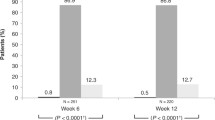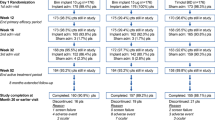Abstract
A multicenter, randomized, investigator-masked, parallel-group trial compared bimatoprost and latanoprost for efficacy and safety in patients with glaucoma or ocular hypertension. Patients received bimatoprost 0.03% (n = 119) or latanoprost 0.005% (n = 113) once daily in the evening for 3 months. Visits were at prestudy, baseline (day 0), week 1, and months 1, 2, and 3. Primary outcome measures were mean IOP and the percentage of patients achieving IOP of 17 mm Hg or lower at 8:00 am. Secondary outcome measures were diurnal IOP measurements (8:00 am, 12 noon, 4:00 pm, 8:00 pm) at month 3 and safety measures including adverse events. Mean IOP was lower with bimatoprost than with latanoprost at all time points during the 3-month follow-up, although the between-group difference was not always statistically significant. At month 3 at 12 noon, mean IOP was as much as 1.0 mm Hg lower with bimatoprost (P = .021 ). Target pressures of ≤17 mm Hg were reached more often with bimatoprost than with latanoprost at 8:00 am (53% vs 43%;P= .029). Over all diurnal measurements at month 3, low target pressures of ≤13, ≤14, and ≤15 mm Hg were achieved significantly more often with bimatoprost (P≤.006). Both drugs were safe and well tolerated. Conjunctival hyperemia was more common with bimatoprost, while headache was more frequent with latanoprost. Bimatoprost provided lower mean pressures than latanoprost at every time point throughout the study and was statistically superior in achieving low target pressures. More patients reached low target pressures with bimatoprost.
Similar content being viewed by others
References
Woodward DF, Krauss AH, Chen J, et al. The pharmacology of bimatoprost (Lumigan™).Surv Ophthalmol. 2001;45(suppl 4):S337-S345.
Sherwood M, Brandt J, for the Bimatoprost Study Groups 1 & 2. 6-Month comparison of bimatoprost once-daily and twice-daily with timolol twice-daily in patients with elevated IOP.Surv Ophthalmol. 2001;45(suppl 4):S361-S368.
DuBiner H, Cooke D, Dirks M, et al. Efficacy and safety of bimatoprost in patients with elevated IOP: a 30-day comparison with latanoprost.Surv Ophthalmol. 2001;45(suppl 4):S353-S360.
Morikawa T, Yoshida M. A useful testing strategy in phase II trials: combined test of superiority and test of equivalence.J Biopharm Stat. 1995;5:297–306.
The Advanced Glaucoma Intervention study (AGIS) Investigators. The relationship between control of intraocular pressure and visual field deterioration.Am J Ophthalmol. 2000;130: 429–440.
Shirakashi M, Iwata K, Sawaguchi S, Abe H, Nanba K. Intraocular pressure-dependent progression of visual field loss in advanced primary open-angle glaucoma: a 15-year follow-up.Ophthalmologica. 1993;207:1–5.
Collaborative Normal-Tension Glaucoma Study Group. Comparison of glaucomatous progression between untreated patients with normal-tension glaucoma and patients with therapeutically reduced intraocular pressures.Am J Ophthalmol. 1998;126:487–497. Published erratum appears in AmJ Ophthalmol. 1999;27:120.
Orzalesi N, Rossetti L, Invernizzi T, Bottoli A, Autelitano A. Effect of timolol, latanoprost, and dorzolamide on circadian IOP in glaucoma or ocular hypertension.Invest Ophthalmol Vis Sci. 2000;41:2566–2573.
Asrani S, Zeimer R, Wilensky J, et al. Large diurnal fluctuations in intraocular pressure are an independent risk factor in patients with glaucoma.J Glaucoma. 2000;9:134–142.
Sacca SC, Rolando M, Marletta A, et al. Fluctuations of intraocular pressure during the day in open-angle glaucoma, normal-tension glaucoma and normal subjects.Ophthalmologica. 1998;212:115–119.
Zeimer RC, Wilensky JT, Gieser DK. Presence and rapid decline of early morning intraocular pressure peaks in glaucoma patients.Ophthalmology. 1990;97:547–550.
Wistrand PJ, Stjernschantz J, Olsson K. The incidence and time-course of latanoprost-induced iridial pigmentation as a function of eye color.Surv Ophthalmol. 1997;41(suppl 2):S129-S138.
Weston BC. Migraine headache associated with latanoprost.Arch Ophthalmol. 2001;119:300–301.
Author information
Authors and Affiliations
Rights and permissions
About this article
Cite this article
Gandolfi, S., Simmons, S.T., Sturm, R. et al. Three-month comparison of bimatoprost and latanoprost in patients with glaucoma and ocular hypertension. Adv Therapy 18, 110–121 (2001). https://doi.org/10.1007/BF02850299
Issue Date:
DOI: https://doi.org/10.1007/BF02850299




